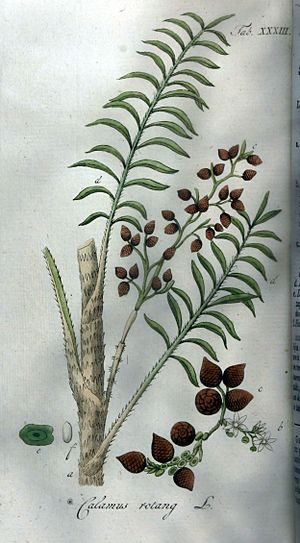Common rattan facts for kids
Quick facts for kids Common rattan |
|
|---|---|
 |
|
| Scientific classification | |
| Genus: |
Calamus (palm)
|
| Species: |
rotang
|
| Synonyms | |
|
|
Calamus rotang, also known as common rattan, is a special type of climbing palm plant. It grows naturally in countries like India, Sri Lanka, and Myanmar. People use this plant to make many things, especially furniture and baskets.
Contents
All About Common Rattan
Common rattan is a type of rattan palm. These palms are known for being "scandent," which means they are climbing plants. They use other plants or structures to grow upwards and outwards.
Where Does Common Rattan Live?
This plant is found in parts of Southwest Asia. It loves warm, tropical places. It is native to India, Sri Lanka, and Myanmar.
How Does Rattan Grow?
The bottom part of the rattan plant grows straight up for about 10 meters (around 33 feet). After that, its main stem starts to grow horizontally. This stem is thin, only a few centimeters wide, but it can grow for 200 meters (over 650 feet) or even more!
The stem is very flexible and has a consistent thickness. It often has sharp, backward-facing spines. These spines help the plant climb and hold onto other plants as it grows. Its leaves are "pinnate," meaning they look like feathers, and are about 60–80 centimeters (24–31 inches) long. They also have two rows of spines on their upper side.
What Are Its Flowers and Fruits Like?
Rattan plants are "dioecious." This means that male and female flowers grow on separate plants. The flowers grow in pretty clusters called "inflorescences." These clusters are protected by spiny leaf-like structures called "spathes."
The fruits of the common rattan are shaped like a top. They are covered in shiny, reddish-brown scales that overlap like roof tiles. When you cut the fruit, it releases a red, sticky liquid. This liquid is a special resin known as "dragon's blood." It has been used in traditional medicine and for commercial purposes. The fruits are also edible.
What is Rattan Used For?
The strong, flexible stems of common rattan are called "canes." These canes are very popular and can be quite expensive. They are used to make many different items, such as:
- Malacca cane furniture
- Baskets
- Walking sticks
- Umbrellas
- Tables
- General wickerwork (items woven from flexible plant material)
Because rattan canes are so sought after, other plants are sometimes used as replacements. These include plants like bamboo, rushes, and osier willows.
Gallery
See also
 In Spanish: Calamus rotang para niños
In Spanish: Calamus rotang para niños






